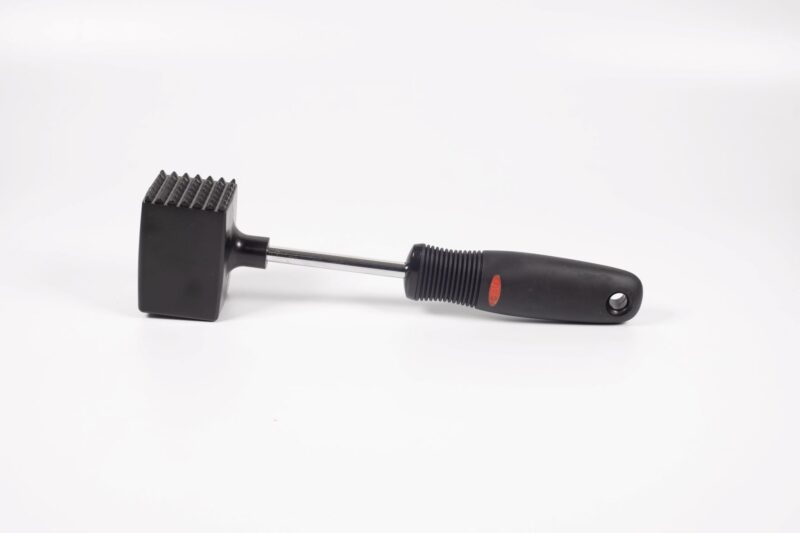Mastering the Art of Tenderizing: Your Ultimate Guide to Chicken Tenderizer Techniques
Introduction:
Mastering the Art of Tenderizing: Your Ultimate Guide to Chicken Tenderizer Techniques
Tenderizing chicken is a crucial step in achieving a juicy and flavorful dish. Whether you’re a seasoned chef or a home cook looking to elevate your culinary skills, understanding the various chicken tenderizer techniques is essential. In this ultimate guide, we will explore different methods and tools that can help you achieve perfectly tender chicken every time. From mechanical tenderizers to marinades and brines, we will delve into the science behind tenderizing and provide you with practical tips and tricks to enhance the texture and taste of your chicken dishes. Get ready to unlock the secrets of tenderizing chicken and take your cooking to the next level.
The Importance of Tenderizing Chicken: Enhancing Flavor and Texture
Are you tired of eating tough and chewy chicken? Do you want to take your culinary skills to the next level? Well, look no further! In this ultimate guide, we will delve into the art of tenderizing chicken and explore various techniques that will enhance both the flavor and texture of your favorite poultry dishes.
Tenderizing chicken is a crucial step in the cooking process that should not be overlooked. It not only improves the taste and tenderness of the meat but also allows for better absorption of marinades and seasonings. By tenderizing your chicken, you can transform a simple dish into a culinary masterpiece.
One of the most common methods of tenderizing chicken is through the use of a meat mallet. This handy tool helps break down the tough muscle fibers in the meat, resulting in a more tender and juicy texture. To use a meat mallet, place the chicken between two sheets of plastic wrap and gently pound it with the flat side of the mallet. Be sure to apply even pressure to avoid tearing the meat.
Another technique that can be used to tenderize chicken is marinating. Marinating involves soaking the chicken in a flavorful liquid for a period of time, allowing the meat to absorb the flavors and become more tender. Acidic ingredients such as lemon juice, vinegar, or yogurt are commonly used in marinades as they help to break down the proteins in the meat. Simply place the chicken in a resealable bag or a shallow dish, pour the marinade over it, and let it sit in the refrigerator for at least 30 minutes or up to overnight.
If you’re short on time, you can also try using a natural meat tenderizer. Papaya, pineapple, and kiwi are all fruits that contain enzymes that help break down proteins and tenderize meat. Simply puree the fruit and rub it onto the chicken, allowing it to sit for about 15 minutes before cooking. Be careful not to leave it on for too long, as the enzymes can over-tenderize the meat and turn it mushy.
Velveting is another technique that can be used to tenderize chicken. This Chinese cooking method involves coating the chicken in a mixture of egg whites, cornstarch, and a small amount of oil. The chicken is then briefly blanched in boiling water or oil before being stir-fried or added to soups and stews. Velveting creates a protective coating around the meat, resulting in a tender and velvety texture.
Lastly, using a brine solution can also help tenderize chicken. Brining involves soaking the chicken in a mixture of salt and water for a period of time. The salt in the brine helps to break down the proteins in the meat, resulting in a more tender and flavorful chicken. To make a basic brine, dissolve 1/4 cup of salt in 4 cups of water and submerge the chicken in the solution for at least 30 minutes or up to overnight.
In conclusion, tenderizing chicken is an essential step in creating delicious and mouthwatering dishes. Whether you choose to use a meat mallet, marinate, use natural tenderizers, velvet, or brine, each technique has its own unique benefits. So, why settle for tough and chewy chicken when you can master the art of tenderizing and elevate your cooking to new heights? Give these techniques a try and prepare to be amazed by the incredible flavor and texture that can be achieved. Happy cooking!
Top 5 Chicken Tenderizing Techniques Every Home Cook Should Know
Are you tired of serving tough and chewy chicken to your family and friends? Do you want to take your cooking skills to the next level and master the art of tenderizing chicken? Look no further! In this article, we will share with you the top 5 chicken tenderizing techniques that every home cook should know. So, grab your apron and let’s get started!
1. Marinating: The first technique on our list is marinating. Marinating chicken not only adds flavor but also helps to break down the tough fibers, resulting in tender and juicy meat. To marinate chicken, simply combine your choice of marinade ingredients such as lemon juice, vinegar, yogurt, or buttermilk with herbs and spices. Place the chicken in a ziplock bag or a container, pour the marinade over it, and let it sit in the refrigerator for at least 30 minutes or overnight for maximum tenderness.
2. Pounding: Pounding chicken is a great way to tenderize it, especially when dealing with thicker cuts or boneless, skinless breasts. To pound chicken, place it between two sheets of plastic wrap or wax paper and use a meat mallet or a rolling pin to gently pound it until it reaches an even thickness. This technique not only tenderizes the meat but also helps it cook more evenly, reducing the risk of overcooking.
3. Brining: Brining is a technique that involves soaking chicken in a saltwater solution before cooking. The saltwater helps to break down the proteins in the meat, resulting in a more tender and flavorful chicken. To brine chicken, dissolve salt and sugar in water, add your choice of herbs and spices, and submerge the chicken in the brine for at least 1 hour or up to 24 hours. Rinse the chicken thoroughly before cooking to remove any excess salt.
4. Velveting: Velveting is a Chinese cooking technique that involves coating chicken with a mixture of egg whites, cornstarch, and a small amount of oil. This technique creates a protective layer around the chicken, preventing it from drying out during cooking and resulting in incredibly tender and moist meat. To velvet chicken, whisk together egg whites, cornstarch, and oil until smooth. Coat the chicken in the mixture and let it sit for 15-30 minutes before cooking.
5. Enzyme-based Tenderizers: Last but not least, enzyme-based tenderizers are a great option for tenderizing chicken. These tenderizers, such as papaya, pineapple, or kiwi, contain natural enzymes that break down the proteins in the meat, resulting in a more tender texture. Simply puree the fruit of your choice and use it as a marinade or a sauce for your chicken. Be careful not to over-marinate, as the enzymes can make the meat mushy if left for too long.
Now that you know the top 5 chicken tenderizing techniques, it’s time to put them into practice and elevate your cooking game. Whether you choose to marinate, pound, brine, velvet, or use enzyme-based tenderizers, these techniques will help you achieve tender and delicious chicken every time. So, go ahead and experiment with these methods, and soon you’ll be known as the master of tenderizing in your kitchen. Happy cooking!
Exploring Different Tenderizing Tools for Perfectly Tender Chicken

Are you tired of tough and chewy chicken? Do you dream of sinking your teeth into a juicy and tender piece of poultry? Well, you’re in luck! In this ultimate guide to chicken tenderizer techniques, we will explore different tools that can help you achieve perfectly tender chicken every time.
One of the most popular and effective tools for tenderizing chicken is a meat mallet. This handy kitchen gadget is essentially a heavy hammer with a flat surface. To use it, simply place the chicken between two sheets of plastic wrap or wax paper and gently pound it with the mallet. The force of the mallet breaks down the muscle fibers in the chicken, resulting in a more tender texture.
If you don’t have a meat mallet, don’t worry! There are other tools you can use to achieve similar results. A rolling pin, for example, can be a great substitute. Just like with a meat mallet, place the chicken between two sheets of plastic wrap or wax paper and roll over it with the rolling pin. The weight and pressure of the rolling pin will help tenderize the chicken.
Another tool that can be used for tenderizing chicken is a meat tenderizer. This tool typically has multiple small blades or prongs that pierce the surface of the meat, allowing marinades and seasonings to penetrate deeper. To use a meat tenderizer, simply press it firmly into the chicken, making sure to cover the entire surface. This technique not only tenderizes the chicken but also enhances its flavor.
If you prefer a more hands-off approach, you can also use a marinade to tenderize your chicken. Marinades are a mixture of acidic ingredients, such as vinegar or citrus juice, along with herbs, spices, and oils. The acid in the marinade helps break down the proteins in the chicken, resulting in a more tender texture. To use a marinade, simply place the chicken in a resealable plastic bag or a shallow dish, pour the marinade over it, and let it sit in the refrigerator for at least 30 minutes or up to overnight.
For those who love gadgets, there are also mechanical tenderizers available on the market. These devices use small blades or needles to pierce the chicken, similar to a meat tenderizer. Some mechanical tenderizers even have a rotating drum that tenderizes the chicken as it spins. While these tools can be effective, they may not be necessary for everyday home cooking.
No matter which tool you choose, it’s important to handle chicken with care to prevent cross-contamination. Always wash your hands and any utensils or surfaces that come into contact with raw chicken to avoid the spread of bacteria.
In conclusion, tenderizing chicken doesn’t have to be a daunting task. With the right tools and techniques, you can achieve perfectly tender chicken every time. Whether you opt for a meat mallet, a rolling pin, a meat tenderizer, or a marinade, the key is to break down the muscle fibers in the chicken to achieve that desired tenderness. So go ahead, experiment with different tenderizing tools, and elevate your chicken dishes to a whole new level of deliciousness!
Mastering the Art of Poultry Tenderizing: Tips and Tricks from the Pros
Are you tired of eating tough and chewy chicken? Do you want to learn the secrets of tenderizing poultry like a pro? Look no further! In this ultimate guide, we will take you through the art of tenderizing chicken, sharing tips and tricks from the pros that will elevate your cooking game to a whole new level.
First and foremost, let’s talk about why tenderizing chicken is important. Chicken, especially the breast meat, can be quite tough and dry if not prepared properly. Tenderizing helps break down the muscle fibers, making the meat more tender and juicy. It also allows marinades and seasonings to penetrate deeper, enhancing the flavor of the chicken.
One of the most common methods of tenderizing chicken is pounding. To do this, place the chicken breast between two sheets of plastic wrap or wax paper and gently pound it with a meat mallet or rolling pin. Start from the center and work your way outwards, being careful not to tear the meat. Pounding not only tenderizes the chicken but also helps to even out its thickness, ensuring even cooking.
Another technique that the pros swear by is brining. Brining involves soaking the chicken in a saltwater solution for a few hours before cooking. The saltwater helps to break down the proteins in the meat, resulting in a more tender and flavorful chicken. To make a basic brine, dissolve 1/4 cup of salt in 4 cups of water and submerge the chicken in the solution. You can also add herbs, spices, and even sugar to the brine for added flavor.
Marinating is another fantastic way to tenderize chicken. A marinade is a mixture of oil, acid (such as vinegar or citrus juice), and seasonings that you soak the chicken in before cooking. The acid in the marinade helps to break down the proteins, resulting in a more tender and flavorful chicken. For best results, marinate the chicken for at least 30 minutes, but no more than 24 hours, depending on the recipe.
If you’re short on time, you can also use a commercial meat tenderizer. These products contain enzymes that break down the proteins in the meat, resulting in a tender and juicy chicken. Simply sprinkle the tenderizer on both sides of the chicken and let it sit for about 30 minutes before cooking. Be sure to follow the instructions on the packaging for best results.
In addition to these techniques, there are a few other tips and tricks that can help you achieve perfectly tender chicken. For instance, using a meat thermometer to ensure that the chicken is cooked to the correct internal temperature will prevent overcooking and drying out the meat. Additionally, allowing the chicken to rest for a few minutes after cooking will help the juices redistribute, resulting in a more tender and flavorful chicken.
Now that you have mastered the art of tenderizing chicken, it’s time to put your skills to the test. Whether you choose to pound, brine, marinate, or use a commercial tenderizer, these techniques will surely elevate your chicken dishes to new heights. So go ahead, get creative with your seasonings and flavors, and enjoy the tender and juicy chicken you deserve!
From Marinating to Velveting: Innovative Cooking Methods for Tender Chicken
Are you tired of tough and chewy chicken? Do you dream of sinking your teeth into tender, juicy meat that practically melts in your mouth? Well, you’re in luck! In this ultimate guide to chicken tenderizer techniques, we will explore a variety of innovative cooking methods that will transform your poultry into a succulent masterpiece. From marinating to velveting, we’ve got you covered!
Let’s start with the basics: marinating. Marinating is a tried and true method that involves soaking your chicken in a flavorful liquid for an extended period of time. This not only infuses the meat with delicious flavors but also helps to break down the tough fibers, resulting in a more tender texture. Whether you prefer a simple mixture of oil, vinegar, and herbs or a complex blend of spices and citrus juices, marinating is a fantastic way to tenderize your chicken.
If you’re short on time, fear not! There are other techniques that can yield tender chicken in a fraction of the time. One such method is brining. Brining involves soaking your chicken in a saltwater solution, which helps to retain moisture and enhance the natural flavors of the meat. The salt in the brine also works to break down the proteins, resulting in a more tender and juicy chicken. So, next time you’re in a rush, consider giving brining a try!
Now, let’s dive into the world of velveting. Velveting is a Chinese cooking technique that involves coating your chicken in a mixture of egg whites, cornstarch, and a touch of oil before cooking it. This unique method creates a protective layer around the meat, preventing it from drying out and ensuring a tender and velvety texture. Velveting is particularly popular in stir-fry dishes, where the chicken is cooked quickly over high heat. So, if you’re looking to achieve that restaurant-quality stir-fry at home, velveting is the way to go!
Another innovative technique for tenderizing chicken is pounding. This method involves using a meat mallet or a rolling pin to flatten the chicken breasts to an even thickness. By doing so, you not only tenderize the meat but also ensure that it cooks evenly. Pounding is especially useful when working with thicker cuts of chicken, as it helps to break down the tough fibers and create a more uniform texture. So, grab your mallet and get ready to pound your way to tender chicken!
Last but not least, we have the power of slow cooking. Slow cooking involves cooking your chicken at a low temperature for an extended period of time. This gentle cooking method allows the collagen in the meat to break down, resulting in a tender and fall-off-the-bone texture. Whether you choose to use a slow cooker, an oven, or a stovetop, slow cooking is a foolproof way to achieve tender chicken every time.
In conclusion, mastering the art of tenderizing chicken is all about exploring different techniques and finding what works best for you. Whether you prefer marinating, brining, velveting, pounding, or slow cooking, each method offers its own unique benefits and can help you achieve that tender and juicy chicken you’ve always dreamed of. So, don’t be afraid to get creative in the kitchen and experiment with these innovative cooking techniques. Your taste buds will thank you!
Delicious and Easy Chicken Recipes for Flavorful Meals
Are you tired of eating tough and chewy chicken? Do you want to take your chicken dishes to the next level? Look no further! In this ultimate guide, we will explore various techniques to tenderize chicken, ensuring that every bite is juicy and flavorful. Whether you’re a seasoned chef or a beginner in the kitchen, these tips and tricks will help you master the art of tenderizing chicken.
One of the simplest and most effective ways to tenderize chicken is by using a meat mallet. This handy tool allows you to pound the chicken breasts to an even thickness, breaking down the tough muscle fibers. To do this, place the chicken between two sheets of plastic wrap and gently pound it with the flat side of the mallet. Be careful not to go overboard and turn the chicken into a mushy mess!
Another technique to tenderize chicken is marinating. Marinating not only adds flavor but also helps to break down the proteins in the meat, resulting in a more tender texture. You can create a simple marinade using ingredients like lemon juice, vinegar, yogurt, or buttermilk. Simply place the chicken in a zip-top bag, pour in the marinade, seal the bag, and let it sit in the refrigerator for at least 30 minutes or up to overnight. The longer you marinate, the more tender and flavorful the chicken will be.
If you’re short on time, you can also use a brine to tenderize chicken. Brining involves soaking the chicken in a saltwater solution, which helps to retain moisture and break down the proteins. To make a basic brine, dissolve salt and sugar in water, and then submerge the chicken in the mixture for at least 30 minutes. Rinse the chicken thoroughly before cooking to remove any excess salt.
For those who prefer a hands-off approach, consider using a natural meat tenderizer. Papaya, pineapple, and kiwi are all fruits that contain enzymes that can help tenderize chicken. Simply puree the fruit and use it as a marinade or rub it directly onto the chicken. Be cautious with the amount of time you leave the fruit on the chicken, as it can turn the meat mushy if left for too long.
In addition to these techniques, cooking methods can also play a role in tenderizing chicken. Slow cooking, braising, and stewing are all great options for achieving tender and juicy chicken. These methods involve cooking the chicken at a low temperature for an extended period, allowing the meat to become tender and flavorful. You can also try using a pressure cooker or an Instant Pot for quick and tender results.
Now that you have mastered the art of tenderizing chicken, it’s time to put your skills to the test with some delicious recipes. From classic favorites like chicken piccata and lemon herb roasted chicken to exotic dishes like Thai coconut curry chicken and honey mustard glazed chicken, the possibilities are endless. Experiment with different flavors and techniques to create your own signature dishes that will impress family and friends.
In conclusion, tenderizing chicken is an essential skill for any home cook. Whether you choose to use a meat mallet, marinate, brine, or use natural tenderizers, the goal is to break down the tough muscle fibers and create a juicy and flavorful chicken. Combine these techniques with various cooking methods, and you’ll be well on your way to creating delicious and tender chicken dishes that will leave everyone asking for seconds. So, roll up your sleeves, grab your ingredients, and get ready to master the art of tenderizing chicken!
Conclusion
In conclusion, mastering the art of tenderizing chicken is essential for achieving juicy and flavorful results. This ultimate guide provides various techniques to tenderize chicken, including marinating, pounding, brining, and using natural tenderizers like yogurt or pineapple juice. By following these techniques, you can elevate your cooking skills and create delicious, tender chicken dishes that will impress your family and friends.
 Wnkrs Blog Celebrating Every Style and Space
Wnkrs Blog Celebrating Every Style and Space





